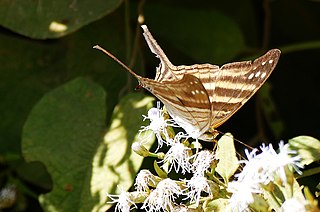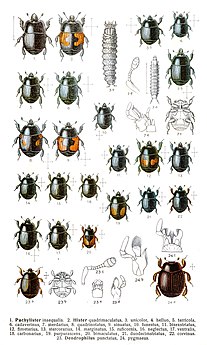
Convolvulaceae, known commonly as the bindweed or morning glory family, is a family of about 60 genera and more than 1,650 species of mostly herbaceous vines, but also trees, shrubs and herbs, and also including the sweet potato and a few other food tubers.
Marco Scacchi was an Italian composer and writer on music.
Plesiocis cribrum is a species of beetle in the family Ciidae, the only species in the genus Plesiocis.

Saprininae is a subfamily of clown beetles in the family Histeridae. There are more than 50 genera and 800 described species in Saprininae.
Polygonus savigny, or Manuel's skipper, is a species of dicot skipper in the butterfly family Hesperiidae. It is found in North America.
Euspilotus azurescens is a species of clown beetle in the family Histeridae. It is found in Central America, North America, and South America.
Euspilotus is a genus of clown beetles in the family Histeridae. There are more than 80 described species in Euspilotus.

Proteides mercurius, the mercurial skipper, is a species of dicot skipper in the butterfly family Hesperiidae. It is found in the Caribbean Sea, Central America, North America, and South America.
Euspilotus auctus is a species of clown beetle in the family Histeridae. It is found in Central America and South America.
Euspilotus scissus is a species of clown beetle in the family Histeridae. It is found in North America.

Marpesia chiron, the many-banded daggerwing, is a species of daggerwings, map butterflies in the family Nymphalidae. It is found in Central America, North America, and South America.
Euspilotus placidus is a species of clown beetle in the family Histeridae. It is found in Central America and North America.

Stilobezzia is a genus of predaceous midges in the family Ceratopogonidae. There are more than 330 described species in Stilobezzia.

Electrostrymon angelia, the fulvous hairstreak, is a species of hairstreak in the butterfly family Lycaenidae. It is found in North America.

Ceroplastes is a genus of wax scales in the family Coccidae. There are more than 130 described species in Ceroplastes.
Euspilotus conformis is a species of clown beetle in the family Histeridae. It is found in North America.
Euspilotus assimilis is a species of clown beetle in the family Histeridae. It is found in North America.
Euspilotus rossi is a species of clown beetle in the family Histeridae. It is found in North America.
Euspilotus scrupularis is a species of clown beetle in the family Histeridae. It is found in Central America and North America.
Euspilotus simulatus is a species of clown beetle in the family Histeridae. It is found in North America.








